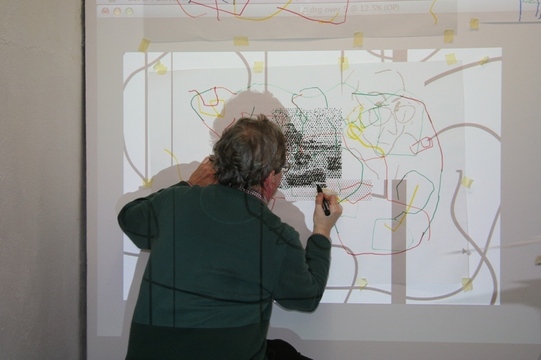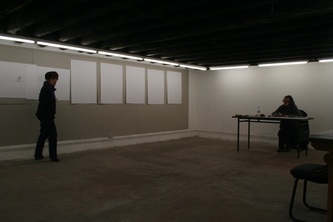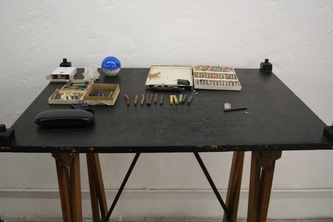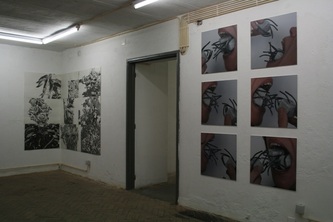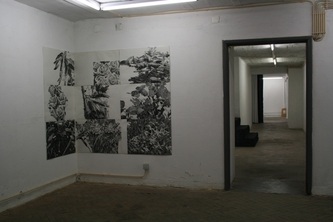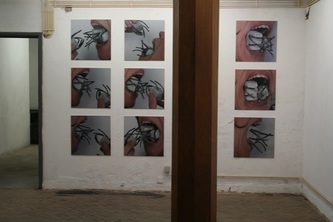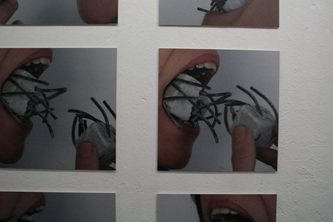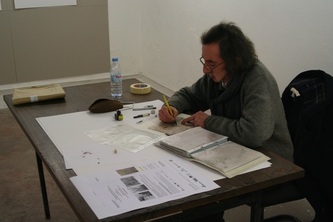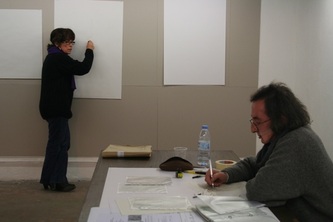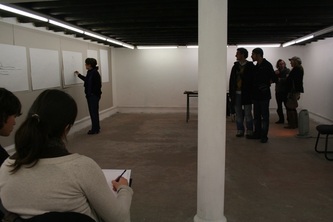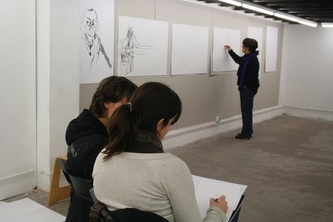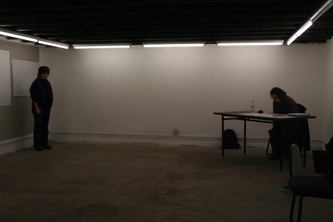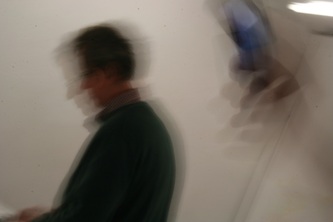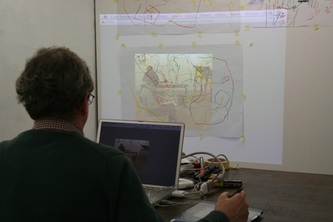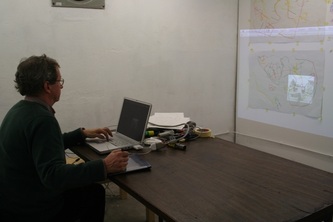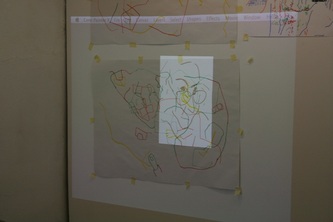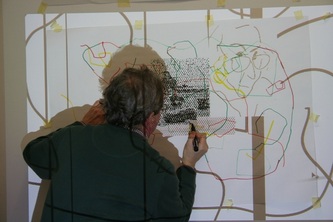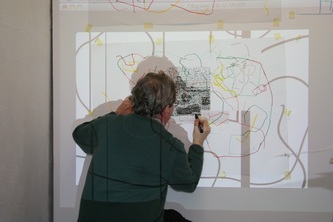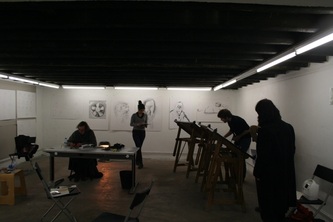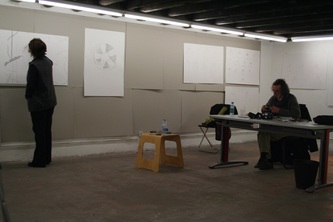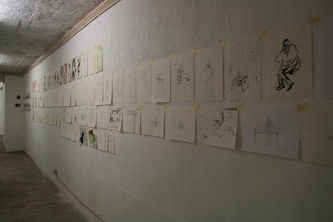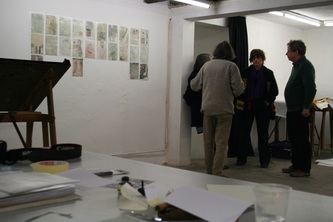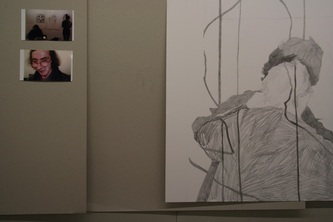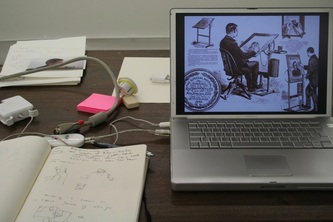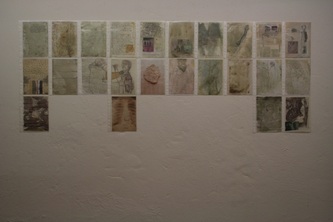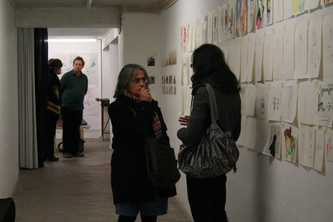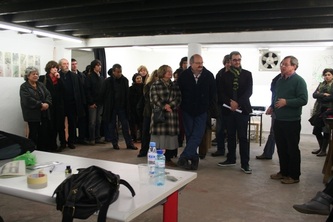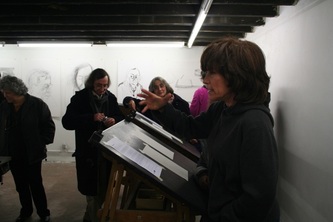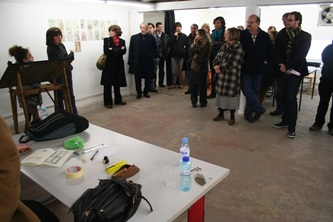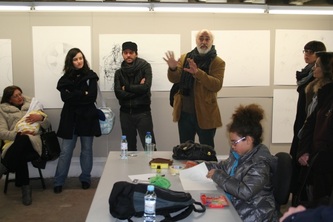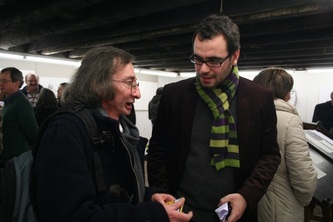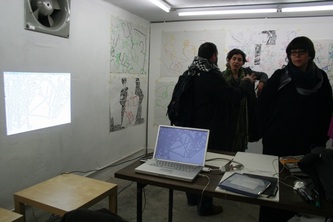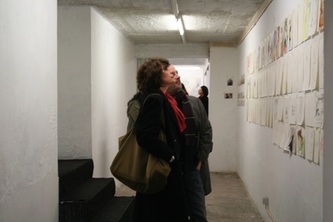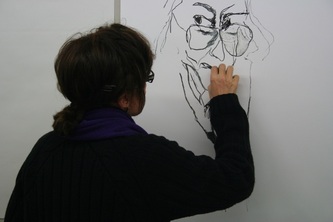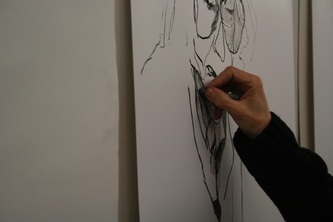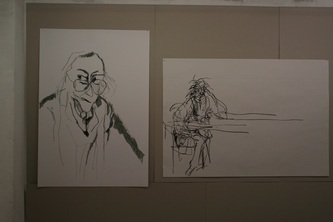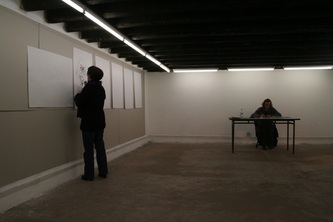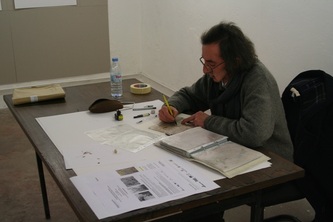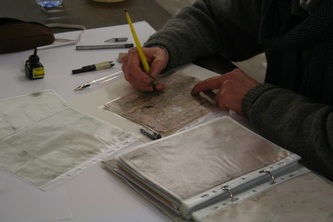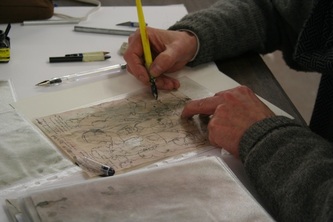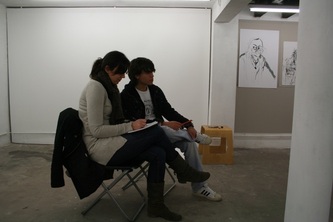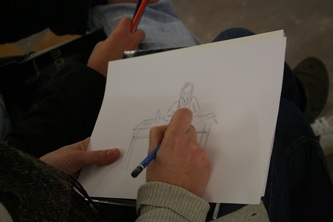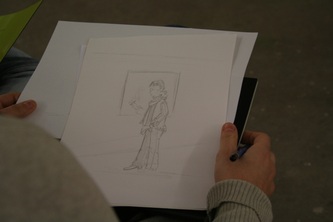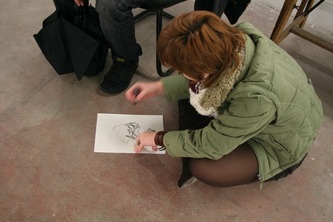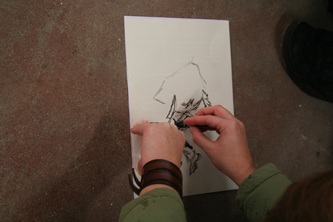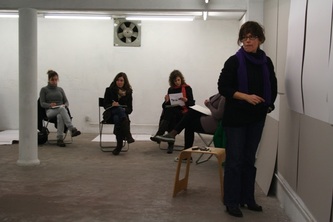_© All rigths reserved to Associação Espaços do
Desenho-Drawing Spaces. Text.Sound.Video.Images
_
P2 – duplicate
The draughtsperson draws him/herself
SERIES OF ACTIVITIES Developed as a response to the project
‘tHE DRAUGHTSPERSON DRAWS HIM/HERSELF’ by ANA LEONOR MADEIRA RODRIGUES, JAMES FAURE WALKER AND PEDRO SARAIVA
(collaborative artist residency which took place at Drawing Spaces in February 2010)
Drawing Spaces, Lisbon, Portugal
3 – 20 FEBRUARY, 2010
The draughtsperson draws him/herself
SERIES OF ACTIVITIES Developed as a response to the project
‘tHE DRAUGHTSPERSON DRAWS HIM/HERSELF’ by ANA LEONOR MADEIRA RODRIGUES, JAMES FAURE WALKER AND PEDRO SARAIVA
(collaborative artist residency which took place at Drawing Spaces in February 2010)
Drawing Spaces, Lisbon, Portugal
3 – 20 FEBRUARY, 2010
REPORT 22 -
IDEAL
Intercultural Drawing for European Adult Learning
Intercultural Drawing for European Adult Learning
WHAT
P2 – duplicate: project produced in collaboration with the artists in residency with various participants, students and members of the public. The aim was for the participants to duplicate the task of the artists, by observing and drawing the artists and other participants who were also observing and drawing. This series of activities were developed through the use of different modes of registering – drawing, photography, video, mobile phone. The results of these parallel projects were exhibited daily as they develop, along with the artists’ works, during opening hours of the open residency.
WHERE
Drawing Spaces, Fábrica de Braço de Prata, Lisbon, Portugal.
WHEN
3 - 20 February (Wednesday to Saturday), 20h - 24h
WHO
Facilitators and Staff
Ana Leonor Rodrigues
James Faure Walker
Pedro Saraiva
(the Artists in Residency at the time at Drawingspaces)
Teresa Carneiro
Fabrice Ziegler
Daniela Vasco
Ricardo Baptista
Maria João Gamito – respondent to the project on the presentation event
ADULT LEARNERS
19 young Female and Male adults, with an age range between 23 and 35 years old.
(This workshop was open to anyone)
WHY
During the period of 17 days, three artists - Ana Leonor Madeira Rodrigues, James Faure Walker, Pedro Saraiva – gathered to draw and portray one other obsessively, as part of a residency project at Drawing Spaces under the theme The draughtswomen/men draw one another.
The modes of register varied, more or less directly referring to traditional drawing.
P2 (project2) duplicate - To the groups of participants it was proposed to draw and observe the draughtswomen/men drawing, becoming themselves also draughtswomen/men. Two parallel paths were aimed to be established here. Apart from the traditional methods of drawing, other working methods were also used in P2 dulicate: photography, transposition, transference, digital manipulation, video, drawing projections as well as drawings from projections, etc. Participants were also encouraged to experiment with, and appropriate some of the drawing techniques used by the artists in residency.
Statements of the artists regarding this project:
Ana Leonor Madeira Rodrigues
The draughtsperson is usually someone who observes and within that action of observing, removes himself from the ‘reality’ which is recognizable in front of his eyes.
Although this is not an absolute verification, this is true in many circumstances; as for me, when I look and draw, although I attach parts of myself to these drawings, I am rarely the object of my own observation.
For this project, myself and two friends, Pedro Saraiva and James Faure Walker, have agreed to coincide in one action the act of observing and of being observed. In this way, during seventeen days we will ‘force’ ourselves to simultaneously draw and act as models for one another.
This action will directly become concerned with the relationship between the draughtsperson and the model, subverting the place of both, as these will continuously interchange, no longer allowing anyone to fix himself as either the draughstperson or the model.
Being conscious that today is common to establish the parameters of an artistic work through a kind of script, what I intend to do is nevertheless something more basic: to place myself in front of a pile of paper holding a pencil in my hand, and work with two people that I know well as draughtsmen. I will draw together with them, both in the role of draughtswomen and in the role of model. It will be like diving into the pleasure of drawing.
James Faure Walker
My part of this proposal will be to observe and draw my two colleagues who will be also drawing in this space. Initially I will draw on paper, in pen or, or perhaps on a large scale support using felt-tip, or watercolour. My purpose here might be to identify some characteristic movements, such as the positions of the hands, and after, look for a way of incorporating these drawings into a format suitable for one of the paint programs I normally use – Painter, Illustrator, Photoshop. While drawing/painting in digital form, I intend to have this projected onto a wall. This will also give me the option of transcribing the projected image onto paper, or of photographing it, and continuing a drawing on the digital program. I also intend to print and work with some of the resulting image.
Pedro Saraiva
To live/see/inhabit the space of drawing
Off Spaces
Three rectangular spaces of white walls.
Spaces of encounters; spaces for thinking, inscribing and describing the face, the memory, the body, through different modes of registering.
Off time
Three weeks, three different schedules in February; time for sharing the experiences of three actors and various spectators/participants.
Off Physicality
The wall, the floor, the table, the white, the chair, the paper, the pencil, the paintbrush, the ink, the cloth, the computer, the photographic camera, the printer, the hand, the body...
… with these simple elements a project initiates and takes its course...
HOW
P2 – duplicate
Participants were provided with some guidelines to allow them to engage with the project more methodically, whilst avoiding being in blank in terms of how to position themselves in relation to the artists already at work.
To begin with, participants were asked to observe and perceive shape and movement through the camera. Participants were asked to combine the use of elements of traditional drawing and its basic elements – line and spots – to draw through the screen of cellular phone, photographic camera, video, etc. In this way they would replace the traditional ways of producing lines by drawing through the camera screens.
1. Participants started very simply, by watching a human figure or part of it, running its contour and its lines from a distance with a fingertip, drawing in the air. They were asked to imagine that, first, the fingertip, and then the palm of the hand, were a camera that allowed them to discover what happened in the human eye as if they were technological sensors providing information from the fingertip/palm of the hand to the eye. Participants were asked to maintain the focus on the same subject at least during 2-3 minutes while experimenting with this exercise. Then they were asked to repeat several ‘drawings in the air’ at their own pace.
2. On a second stage, participants were asked to repeat the last exercise, although this time using the camera as the fingertip, pointing the camera to the subject as if it were the traditional line maker or pencil. Participants were asked to continue to focus on the figure or parts of it for some time, observing and registering movements and shapes. The camera should wok as the instrument that allowed discovering that which was transmitted to the eye, creating temporary images in the brain. This exercise aimed for the participant to observe and move through space forcing oneself to disconnect and forget the ‘images’ appearing on screen, while allowing the camera to work as a perceptive sensor providing and registering information of lines, shapes and movements in space.
3. On a third stage, participants were asked to use again the camera, this time to draw the figure or part of the figure using the spot/blurb instead of the line. They were to use the screen as a sensor like the palm of their hand, and follow the figure or parts of it as a full shape that trespassed, filled or emptied the space. Participants were also advised to follow the figure or part of the figure, in terms of its movements for some time.
4. On the last stage of these set of exercises, the participants were asked to draw what they observed using a combination of line and spots or blurbs to registered the lines, movements and shapes of bodies in space. They could choose to use any material to produce their drawings, at their own pace, either in a more traditional fashion (paper and pencil) or by combining previous suggested registering modes with new ones.
5. Finally, participants were asked to plunge into the pleasure of drawing…
6. At the end of each daily session, the resultant drawing were hanged on the walls of Drawing Spaces and informal discussions about the project, working processes and results were established between artists, participants and facilitators.
VALUE FOR LEARNERS
Participants were encouraged to use technological devices to emulate the traditional drawing modes of working. The detachment lead to a re-appraisal of the use of drawing methods and techniques by discovering new ways and uses of the line and spot/blurb as drawing. This unpretentious approach to new and more traditional methods of drawing was taken with a lot of enthusiasm by the participants, as they felt that none of the approaches was the ‘right’ one, but that they could be used to serve different purposes, even in combination, while helping to extend their vocabulary of drawing methods and techniques. Participants were at first slightly intimidated to participate in a project by three well known artists. But as these artists were gathered for the project for their huge experience with drawing pedagogies and teaching, the dialogue with the participants was quite mature and fluid, and participants overcame their fears very easily as they felt they were being fully received in a collaborative environment.
VALUE FOR THE FACILITATORS
Facilitators were able to try out and gain experience in ways of making people feel comfortable while drawing in unconventional surfaces through less traditional modes of drawing. This was also a good opportunity to understand the role of the facilitator as a provider of a good workflow, managing moments for providing information, pausing, discussing, encouraging individual exploration and collaboration, by including themselves also in the activities. During this project, facilitators had a huge role in accompanying the participants in their work, through the guidelines, experimenting together with them, explaining the use of devices, and clarifying some of the aims of the guidelines. On the other hand, this session provided also the facilitator with the great opportunity to engage in the critique of work as a healthy and constructive shared moment between artists, facilitators and participants.
VISUAL RECORDS
- An open residency developed in collaboration with 3 artists and with adult participants (during the open residency the public was able to access the workspace and accompany the developmental stages of the work produced both by artists and participants in the project)
- An exhibition of the work produced by artists and the participants
- A presentation and discussion of the project with the participation of both artists and participants
P2 – duplicate: project produced in collaboration with the artists in residency with various participants, students and members of the public. The aim was for the participants to duplicate the task of the artists, by observing and drawing the artists and other participants who were also observing and drawing. This series of activities were developed through the use of different modes of registering – drawing, photography, video, mobile phone. The results of these parallel projects were exhibited daily as they develop, along with the artists’ works, during opening hours of the open residency.
WHERE
Drawing Spaces, Fábrica de Braço de Prata, Lisbon, Portugal.
WHEN
3 - 20 February (Wednesday to Saturday), 20h - 24h
WHO
Facilitators and Staff
Ana Leonor Rodrigues
James Faure Walker
Pedro Saraiva
(the Artists in Residency at the time at Drawingspaces)
Teresa Carneiro
Fabrice Ziegler
Daniela Vasco
Ricardo Baptista
Maria João Gamito – respondent to the project on the presentation event
ADULT LEARNERS
19 young Female and Male adults, with an age range between 23 and 35 years old.
(This workshop was open to anyone)
WHY
During the period of 17 days, three artists - Ana Leonor Madeira Rodrigues, James Faure Walker, Pedro Saraiva – gathered to draw and portray one other obsessively, as part of a residency project at Drawing Spaces under the theme The draughtswomen/men draw one another.
The modes of register varied, more or less directly referring to traditional drawing.
P2 (project2) duplicate - To the groups of participants it was proposed to draw and observe the draughtswomen/men drawing, becoming themselves also draughtswomen/men. Two parallel paths were aimed to be established here. Apart from the traditional methods of drawing, other working methods were also used in P2 dulicate: photography, transposition, transference, digital manipulation, video, drawing projections as well as drawings from projections, etc. Participants were also encouraged to experiment with, and appropriate some of the drawing techniques used by the artists in residency.
Statements of the artists regarding this project:
Ana Leonor Madeira Rodrigues
The draughtsperson is usually someone who observes and within that action of observing, removes himself from the ‘reality’ which is recognizable in front of his eyes.
Although this is not an absolute verification, this is true in many circumstances; as for me, when I look and draw, although I attach parts of myself to these drawings, I am rarely the object of my own observation.
For this project, myself and two friends, Pedro Saraiva and James Faure Walker, have agreed to coincide in one action the act of observing and of being observed. In this way, during seventeen days we will ‘force’ ourselves to simultaneously draw and act as models for one another.
This action will directly become concerned with the relationship between the draughtsperson and the model, subverting the place of both, as these will continuously interchange, no longer allowing anyone to fix himself as either the draughstperson or the model.
Being conscious that today is common to establish the parameters of an artistic work through a kind of script, what I intend to do is nevertheless something more basic: to place myself in front of a pile of paper holding a pencil in my hand, and work with two people that I know well as draughtsmen. I will draw together with them, both in the role of draughtswomen and in the role of model. It will be like diving into the pleasure of drawing.
James Faure Walker
My part of this proposal will be to observe and draw my two colleagues who will be also drawing in this space. Initially I will draw on paper, in pen or, or perhaps on a large scale support using felt-tip, or watercolour. My purpose here might be to identify some characteristic movements, such as the positions of the hands, and after, look for a way of incorporating these drawings into a format suitable for one of the paint programs I normally use – Painter, Illustrator, Photoshop. While drawing/painting in digital form, I intend to have this projected onto a wall. This will also give me the option of transcribing the projected image onto paper, or of photographing it, and continuing a drawing on the digital program. I also intend to print and work with some of the resulting image.
Pedro Saraiva
To live/see/inhabit the space of drawing
Off Spaces
Three rectangular spaces of white walls.
Spaces of encounters; spaces for thinking, inscribing and describing the face, the memory, the body, through different modes of registering.
Off time
Three weeks, three different schedules in February; time for sharing the experiences of three actors and various spectators/participants.
Off Physicality
The wall, the floor, the table, the white, the chair, the paper, the pencil, the paintbrush, the ink, the cloth, the computer, the photographic camera, the printer, the hand, the body...
… with these simple elements a project initiates and takes its course...
HOW
P2 – duplicate
Participants were provided with some guidelines to allow them to engage with the project more methodically, whilst avoiding being in blank in terms of how to position themselves in relation to the artists already at work.
To begin with, participants were asked to observe and perceive shape and movement through the camera. Participants were asked to combine the use of elements of traditional drawing and its basic elements – line and spots – to draw through the screen of cellular phone, photographic camera, video, etc. In this way they would replace the traditional ways of producing lines by drawing through the camera screens.
1. Participants started very simply, by watching a human figure or part of it, running its contour and its lines from a distance with a fingertip, drawing in the air. They were asked to imagine that, first, the fingertip, and then the palm of the hand, were a camera that allowed them to discover what happened in the human eye as if they were technological sensors providing information from the fingertip/palm of the hand to the eye. Participants were asked to maintain the focus on the same subject at least during 2-3 minutes while experimenting with this exercise. Then they were asked to repeat several ‘drawings in the air’ at their own pace.
2. On a second stage, participants were asked to repeat the last exercise, although this time using the camera as the fingertip, pointing the camera to the subject as if it were the traditional line maker or pencil. Participants were asked to continue to focus on the figure or parts of it for some time, observing and registering movements and shapes. The camera should wok as the instrument that allowed discovering that which was transmitted to the eye, creating temporary images in the brain. This exercise aimed for the participant to observe and move through space forcing oneself to disconnect and forget the ‘images’ appearing on screen, while allowing the camera to work as a perceptive sensor providing and registering information of lines, shapes and movements in space.
3. On a third stage, participants were asked to use again the camera, this time to draw the figure or part of the figure using the spot/blurb instead of the line. They were to use the screen as a sensor like the palm of their hand, and follow the figure or parts of it as a full shape that trespassed, filled or emptied the space. Participants were also advised to follow the figure or part of the figure, in terms of its movements for some time.
4. On the last stage of these set of exercises, the participants were asked to draw what they observed using a combination of line and spots or blurbs to registered the lines, movements and shapes of bodies in space. They could choose to use any material to produce their drawings, at their own pace, either in a more traditional fashion (paper and pencil) or by combining previous suggested registering modes with new ones.
5. Finally, participants were asked to plunge into the pleasure of drawing…
6. At the end of each daily session, the resultant drawing were hanged on the walls of Drawing Spaces and informal discussions about the project, working processes and results were established between artists, participants and facilitators.
VALUE FOR LEARNERS
Participants were encouraged to use technological devices to emulate the traditional drawing modes of working. The detachment lead to a re-appraisal of the use of drawing methods and techniques by discovering new ways and uses of the line and spot/blurb as drawing. This unpretentious approach to new and more traditional methods of drawing was taken with a lot of enthusiasm by the participants, as they felt that none of the approaches was the ‘right’ one, but that they could be used to serve different purposes, even in combination, while helping to extend their vocabulary of drawing methods and techniques. Participants were at first slightly intimidated to participate in a project by three well known artists. But as these artists were gathered for the project for their huge experience with drawing pedagogies and teaching, the dialogue with the participants was quite mature and fluid, and participants overcame their fears very easily as they felt they were being fully received in a collaborative environment.
VALUE FOR THE FACILITATORS
Facilitators were able to try out and gain experience in ways of making people feel comfortable while drawing in unconventional surfaces through less traditional modes of drawing. This was also a good opportunity to understand the role of the facilitator as a provider of a good workflow, managing moments for providing information, pausing, discussing, encouraging individual exploration and collaboration, by including themselves also in the activities. During this project, facilitators had a huge role in accompanying the participants in their work, through the guidelines, experimenting together with them, explaining the use of devices, and clarifying some of the aims of the guidelines. On the other hand, this session provided also the facilitator with the great opportunity to engage in the critique of work as a healthy and constructive shared moment between artists, facilitators and participants.
VISUAL RECORDS
